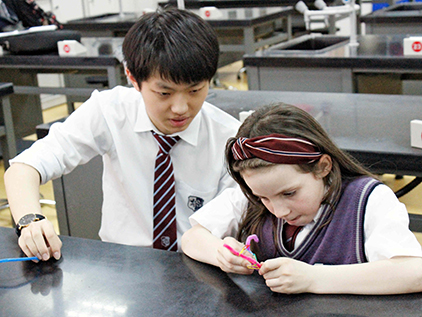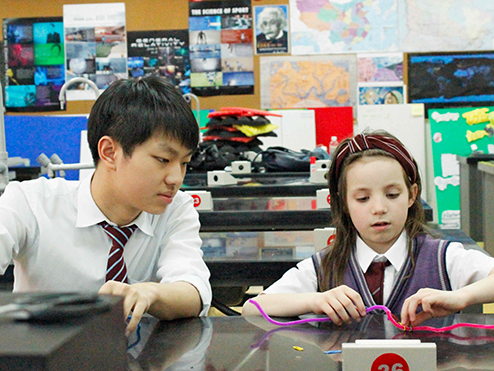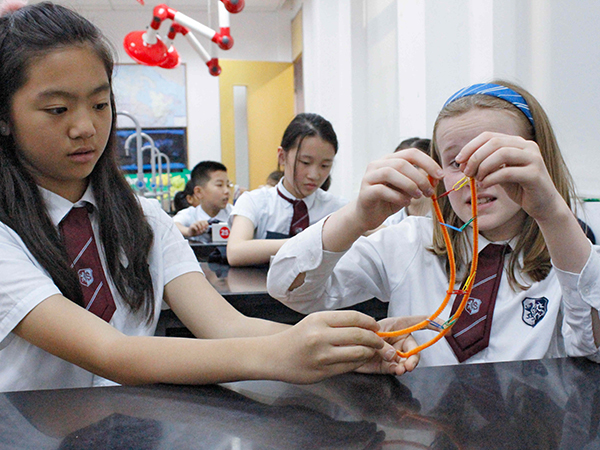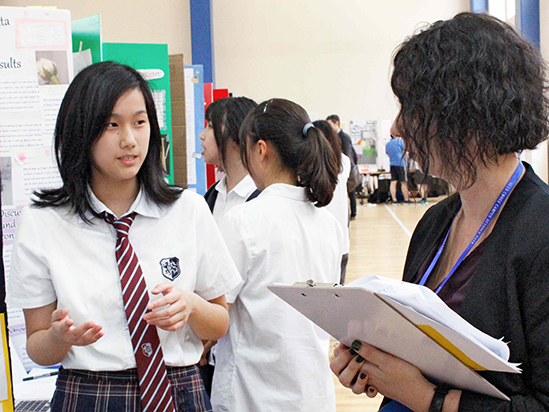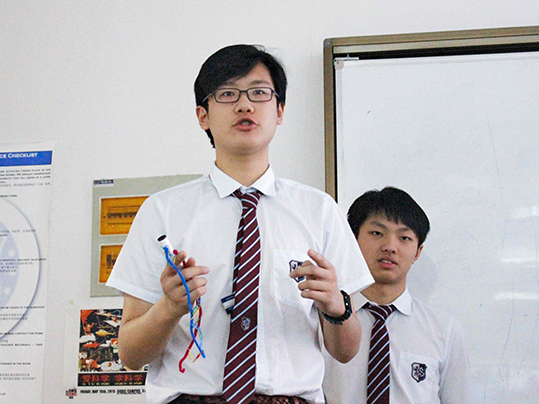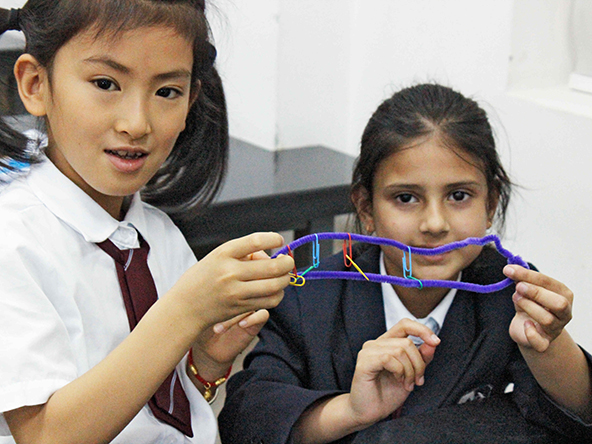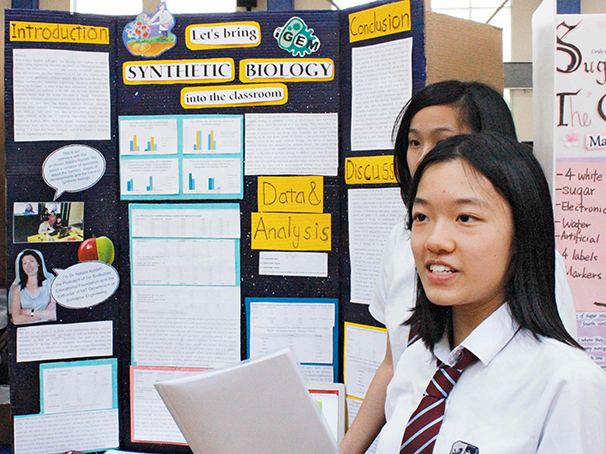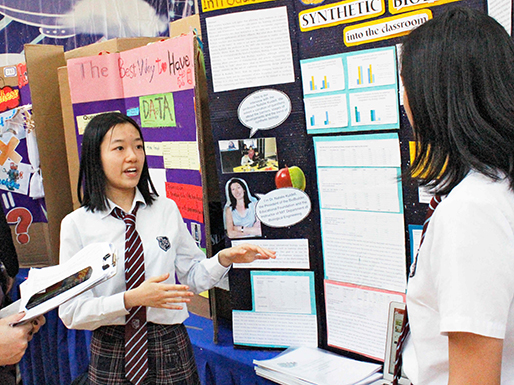
Educational Outreach
Introduction. Motivations & Aims
This project and entire iGEM process has given us such wonderful experiences in the classroom and laboratory. As high school students we have gained an incredible amount of appreciation for how lucky we are to have these opportunities through the afterschool BioBuilder club. It is the second year of BioBuilder at our school and thus, it comes as no surprise that still most of our school community do not know what exactly our club does. Nor have many come to realize that we are becoming part of a global scientific community. All of us in the club are just beginners to the synthetic biology field. In fact most, if not all of us, had never heard of this exciting new field before lst year.
During our learning and exploration, our team generally found the concepts of defining problems, designing solutions, and being autonomous quite challenging, especially in a life science context. Our BioBuilder coach has also taught many of us in honors or AP biology, and we often chatted about how the skill set and demands required for success in regular core classes can at times be quite different. Our instructor expressed his frustration sometimes that some core curriculum are not reflecting real STEM industries and careers, and instead are instead too exam focused and on recall. He wished that he could incorporate more engineering and design tasks and assessments into his core biology courses ala BioBuilder.
Together we saw an opportunity to develop an educational engagement program designed to help the iGEM foundation with one of their key commitments: “to help promote synthetic biology education”. Our program aims to achieve this at the base level - with the biologists, engineers and policy makers of the future in secondary school classrooms. We wanted to create student made lesson plans and guides that any educator teaching a core biology class could implement when appropriate into their curriculum. We hoped that both teachers and students will become more aware of synthetic biology and also begin to develop the skills necessary for the continued advancement of the field.
Approach
Our first point of action in this program was to use the concept of BioBuilder to learn about how to approach creating biodesign and engineering lessons. We learned from an earlier publication by the creators of BioBuilder, what were their educational philosophy surrounding it, and what was their motivation for its development. Kuldell & Dixon (2013), described the positive impact the BioBuilder curriculum had on educators, and their approach, who sampled the BioBuilder training and curriculum. There was a marked increase in educators who indicated they would likely teach engineering and design in biology lessons after the training (figure 1), compared to their current classroom practice (before undertaking the training). We wanted to explore this phenomenon further and also wondered about would there be similar results in international schools such as ours, or indeed did the type of curriculum a school adopts have an impact on this pedagogical approach. We are lucky to be part of a larger educational community in Shanghai as our parent organization operates several different campuses, each with its own unique curriculum and approach to teaching and learning. We decided to design a survey to conduct a study aimed at international schools, with various curricula, in order to investigate our proposed questions and utilize our local resources to help us test and refine our ideas.

Figure 1 - Positive effect of BioBuilder professional development on biodesign and engineering concepts in secondary school biology instruction. Blue bars indicate the percentage of teacher respondents who said they “often” or “frequently” used each concept when teaching their biology classes prior to BioBuilder training. The red bars represent the same teachers who said they would “definatley” incorportae each concept into their teaching in the future.
This survey also aimed to find any relationship between individual educators knowledge and understanding of the field of synthetic biology and their implementation of engineering and biodesign in their classrooms.
We also reached out to Dr. Natalie Kuldell, a professor at the Department of Biological Engineering at the Massachusetts Institute of Technology (MIT), who is also the founder and executive director of BioBuilder and a co author of the aforementioned study. We were honored that Dr. Kuldell was willing to speak to us via video link to discuss approaches to engineering and biodesign curriculum development. The meeting, which took place in April, also allowed us to take the opportunity to learn about potential barriers that may face educators which can both directly and indirectly affected the implementation and advancement of synthetic biology skill development in schools. (see Human practices page for more info about this meeting).
Survey Design
After three months of literature review, conversations with our own school administrators, and our in-depth interview with Dr. Kuldell we began to develop our survey. The first draft of the survey was completed and tested on 10 members of our own school faculty. Very useful feedback was provided, which allowed us to add some questions, and switch from a 4 answer likert scale to a 5 point scale which included a “neutral” view. We also updated our “part 1” of the survey, which profiles the respondent, by adding questions relating to their number of years of teaching experience, and their highest academic award in both biological sciences and education fields. We felt we can see if there may be some relationships between these factors and approach to biodesign & engineering in addition to the type of curriculum taught. Other studies have found that differences in perceptions of, and familiarity with, teaching design, engineering and technology “based on gender, grade level taught, and years of teaching experience” do exist for teachers (Yasar et al., 2006). Part 2 of the survey focused mostly on elucidating these attitudes and feelings among the respondents with respects to the use of engineering and design and its place in biology classrooms. Part 3 of the survey was used to probe for the aforementioned possible barriers affecting teachers implementation of engineering concepts. These questions were designed with inspiration from a previous study into use of inquiry based learning in science classes. Here it was found that “class size, accountability, curricular demands, and administrative support are perceived as constraints that impede the use of inquiry” (DiBaise & McDonald, 2015).
Our survey was finally completed in early May and was shared with life science educators from around the world, through the help of our school community, via both social media groups and official online communities for Advanced Placement (AP), Next generation science standards (NGSS), International Baccalaureate (IB), and Cambridge International Education (CIE) schools. Responses were collected until mid September.
Main findings & Data summary
We received 115 respondents with a completion rate of 80%. Overall the survey took on average 7 minutes to complete. All complete raw data can be downloaded in attachment 1.
One of the most striking findings from the survey is the high frequency of respondents (n = 114) that indicated that they are either “wholly unfamiliar with the topic of synthetic biology” (27%) or who “lack understanding of the topic” (47%) indicating a potential avenue for iGEM to focus on for the advancement of synthetic biology education.
Taking our sample as representative of the whole teaching community (regardless of curriculum, years of experience or academic background), it is clear that engineering and design concepts are not being taught at a high frequency in classes. 42% of respondents said they “rarely” used Engineering and Design when teaching their main biology class (i.e. the class they labelled as their first choice science class), while 16% said they never used these concepts. 35% said they incorporated engineering and design in there classes “sometimes” with only 7% applying them “often and whenever they can”.
As expected, we found that the low frequency of implementation of topics within classes is not down to any moral objections or opposition to the pedagogical approach. We found that respondents viewed engineering and design in biology education favorably. Out of 87 respondents, 84% indicated that they either agree (56%) or strongly agree (28%) with the statement “Teaching biology with embedded Engineering & Design ideas is effective for enhancing student understanding of biological concepts and principles”. Similarly most respondents agreed (55%) or strongly agreed (28%) that Engineering & Design should be integrated into the secondary school biology curricula (n = 87) and in response to the question “I would like to be able to teach my students to understand the use and impact of Design & Engineering in the field of Biology” 54% agreed and 33% strongly agreed. Our findings suggested that educators were experiencing barriers in their professional lives.
We make the tentative conclusions both that teacher training and in-job training is not wholly equipping teachers for the implementation such concepts into their curriculum. For these life science educators who took our survey, 77% of them had never experienced “teaching biology with Engineering & Design” in their formal professional education degree attainment while 81% had never attended any workshop relating to this topic. Interesting, but not surprisingly, out of 88 respondents, well over half either disagreed (42%) or strongly disagreed (17%) about being “confident” in their “abilities to implement engineering and design concepts” into their biology classes. Our survey also more directly seeked to find out what teachers feel inhibits their ability to incorporate more biodesign and engineering into their classes. in agreement with both what Dr. Natalie Kuldell suggested, and with our earlier conclusions, a lack of training opportunities and/ore resources lie at the root of the problem. An overwhelming amount of respondents indicated that there was insufficient training opportunities in biodesign and engineering concepts in biology (37% strongly agreed and 56% agreed that there is a lack of sufficient training), while almost identical results were observed for citing a lack of suitable available resources as a barrier for its implementation (34% strongly agree and 54% agree).
Comparison of Groups
To answer the questions posed about whether differences in numbers of years of teaching or curriculum used has any impact on frequency of use of engineering and design in biology, comparisons between different groups were analyzed. Although there appeared to be some differences between groups when type of curriculum used was compared, Chi-Square Tests indicated the observed differences were not significant (p<0.05). For example when comparing AP Biology and NGSS Life Science classes it would appear that a higher frequency of teachers would use engineering and design in their lessons when following NGSS standards (14% used it often, 40% used them sometimes compared to just 6% and 29% respectively for AP). However these difference were not seen as significant (p=0.14) and we would like to collect more data from NGSS teachers. This data is further clouded by the fact that many respondents taught both NGSS and AP classes and therefore these groups can not be fully described as being independent.
We would like to continue with this line of inquiry in the near future and explore the impact of specific professional development workshops for biodesign. Our current data is insufficient for us to make any conclusions about this as only 12 respondents had received some form of training in this topic. 17% of this that had, did however respond that they often use this in their classes while a further 42% responded that they sometimes did with none admitting to never using engineering and design concepts in heir biology classes. This is compared with 5% (often), 38% (sometimes), and 13% (never) responses from teachers who never received any training. This data looks promising evidence for supporting continued effort into professional training for this purpose but again the differences are not significant (p=0.35). We would like to continue our work to overcome the issue of small sample size.
Conclusion/Action
These results confirmed our initial feelings that student designed lesson plans that can be easily incorporated and aligned to a teachers regular curriculum can have a profound impact on synthetic biology education. The results allowed us to realize that many teachers are unfamiliar with synthetic biology so we concluded that by simply sharing information about iGEM and BioBuilder to teachers, schools and districts is also great starting point. We also learned that we must provide very clear background information in our teachers guides to accompany our lesson plans. The survey also taught us that many teachers feel pressure to prepare students for external examinations and that this has a negative impact with respects to the implementation of engineering and design skills into their classes. We feel further investigation into this aspect is required before any drastic action can take place but we intend to work alongside iGEM, BioBuilder, College Board, and other educational governing bodies to communicate this, and future findings about exam pressures in the hope it may be considered during curriculum review times.
Presently we continued to develop and design a lesson plan which could be shared with the 54 survey respondents who left their email address with us indicating they want to receive samples of our resources. Working closely with our science faculty we decided to format our lesson plans in the recommended 5E instructional model. The lesson plan was shared in early October and at the time of writing we are awaiting feedback from teachers who have used it. We also earlier sent an email to the aforementioned educators directing them to learning materials from BioBuilder.
Throughout the development process we also worked on increasing awareness of iGEM and synthetic biology concepts in our local Shanghai community. In late May we analyzed the early survey data (65 respondents) and summarized our findings for a presentation at the annual middle to high school cross campus science fair. Several Shanghai schools, including science teachers and administrators attend this event so we had a nice platform to introduce our findings. We also gave a presentation on the fundamentals of iGEM and used the 2016 interlab study data as an exemplar of how iGEM can bring schools from around the world into the synthetic biology community. The science fair also gave us a first opportunity to plan and teach an engineering and biodesign lesson.

Our team conducted a brief lecture touching upon the most fundamental engineering design concepts and how they can be used in biology. Our target audience for this activity was younger elementary/middle school students who already express a strong passion for science. This small-scale teaching lesson helped them establish a link between engineering and life science while also providing us with valuable experience in becoming lesson planners. Approximately 50 students and 8 teachers attended the lessons and participated in in-class activity. Feedback was positive from teachers and we were happy to get some instructional advice from these experts.

Finally, responding to our survey respondents concerns about knowing where and when to use engineering and design in their curriculum, we developed a tool called “Biodesign Launchpad” that educators can use to filter through their curriculum student learning objectives per topic and learn of which objectives that can use our lesson plans or indeed begin to design their own incorporated engineering and design lessons. We sincerely hope that this project could be a long-term approach to help the iGEM foundation advance synthetic biology education. Our team, along with our school organization, would like to continue to further develop this toolkit and research for the foreseeable future.
Use of Social Media
Our team also engaged our local community about our project and its relevance to their lives and China’s future green economy. It is well known that China is entering a new age, where environmental issues are more to the fore and the general public are becoming increasingly aware of sustainability and each individuals role in the global community with respects to preserving our natural resources and environment for the next generation. Through our research we found that China is well placed for exploiting the abundant opportunities that exist in sustainable microalgae culturing. Furthermore we learned that the health food product market is growing rapidly in China, driven by the demand of infant formula and supplements for elderly, but that the general public are not aware of the impact products like that can have on global fish stocks or that they can use algae as a safe and renewable source.
We hoped to make more people aware of this by utilizing our very large educational organization to reach a vast audience in Shanghai. Chinese social media outlets attached to our school campus and central organization were utilized to push our articles about iGEM, synthetic biology, microalgae and sustainability. By working hand in hand with our school and central organization leaders as well as the media team employed by our school, we were able to post multiple articles through the course of our studies. We feel it was very successful, with an average “viewings” of over 1,500 for each article from wechat alone. We are continuing to work with our organization to ensure we will continue to have an outlet for the advancement of synthetic biology education and help engage the public in these important issues in sustainability.

References:
Yaşar, &., Baker, D., Robinson‐Kurpius, S., Krause, S., & Roberts, C. (2006). Development of a Survey to Assess K‐12 Teachers' Perceptions of Engineers and Familiarity with Teaching Design, Engineering, and Technology. Journal of Engineering Education, 95(3), 205-216.
DiBiase, Warren, & McDonald, Judith R. (2015). Science Teacher Attitudes toward Inquiry-Based Teaching and Learning. Clearing House: A Journal of Educational Strategies, Issues and Ideas, 88(2), 29-38.
Dixon, James, & Kuldell, Natalie. (2012). Mendel's modern legacy: How to incorporate engineering in the biology classroom. The Science Teacher, 79(2), 52.
Omega 3 Market Size to Reach $3.01 Billion by 2022: Grand View Research, Inc. (2016). PR Newswire, p. PR Newswire, Feb 15, 2016.
EPA/DHA (Omega 3) Ingredients Market worth USD 3.79 Billion by 2022: Global Market Insights, Inc. (2016). M2 Communications, p. M2 Communications, June 9, 2016.
Biodesign Lesson Lauchpad
What Curriculum are you Teaching

AP



NGSS



IB DP


Which topic are you teaching?
Evolution
Energy, Mahtter, Organization & Homeostasis
Inheritance
Systems Biology
Which topic are you teaching?
From molecules to organisms.
Ecosystems: Interactions, Energy & Dynamics
Heredity: Inheritance and Variation of Traits
Biological Evolution: Unity and Diversity
Which topic are you teaching?
Cell Biology
Molecular Biology
Genetics
Human Physiology
LO 1.14 -The student is able to pose scientific questions that correctly identify essential properties of shared, core life processes that provide insights into the history of life on Earth.
LO 1.15 - The student is able to describe specific examples of conserved core biological processes and features shared by all domains or within one domain of life, and how these shared, conserved core processes and features support the concept of common ancestry for all organisms.
LO 2.12 - The student is able to use representations and models to analyze situations or solve problems qualitatively and quantitatively to investigate whether dynamic homeostasis is maintained by the active movement of molecules across membranes.
LO 2.15 - The student can justify a claim made about the effect(s) on a biological
system at the molecular, physiological or organismal level when given a scenario
in which one or more components within a negative regulatory system is altered.
LO 2.16 - The student is able to connect how organisms use negative feedback to maintain their internal environments.
LO 2.17 - The student is able to evaluate data that show the effect(s) of changes in concentrations of key molecules on negative feedback mechanisms.
LO 2.18 - The student can make predictions about how organisms use negative feedback mechanisms to maintain their internal environments.
LO 2.19 - The student is able to make predictions about how positive feedback mechanisms amplify activities and processes in organisms based on scientific theories and models.
LO 2.20 - The student is able to justify that positive feedback mechanisms amplify responses in organisms.
LO 2.23 - The student is able to justify the selection of the kind of data needed to answer scientific questions about the relevant mechanism that organisms use to respond to changes in their external environment.
LO 2.27 - The student is able to connect differences in the environment with the evolution of homeostatic mechanisms.
LO 2.28 - The student is able to use representations or models to analyze quantitatively and qualitatively the effects of disruptions to dynamic homeostasis in biological systems.
LO 2.34 - The student is able to describe the role of programmed cell death in development and differentiation, the reuse of molecules, and the maintenance of dynamic homeostasis.
LO 2.35 - The student is able to design a plan for collecting data to support the scientific claim that the timing and coordination of physiological events involve regulation.
LO 2.36 - The student is able to justify scientific claims with evidence to show how timing and coordination of physiological events involve regulation.
LO 2.40 - The student is able to connect concepts in and across domain(s) to predict how environmental factors affect responses to information and change behavior.
LO 3.6 - The student can predict how a change in a specific DNA or RNA sequence can result in changes in gene expression.
LO 3.18 - The student is able to describe the connection between the regulation of gene expression and observed differences between different kinds of organisms.
LO 3.20 - The student is able to explain how the regulation of gene expression is essential for the processes and structures that support efficient cell function.
LO 3.21 - The student can use representations to describe how gene regulation influences cell products and function.
LO 3.22 - The student is able to explain how signal pathways mediate gene expression, including how this process can affect protein production.
LO 3.23 - The student can use representations to describe mechanisms of the regulation of gene expression.
LO 3.36 - The student is able to describe a model that expresses the key elements of signal transduction pathways by which a signal is converted to a cellular response.
LO 3.37 - The student is able to justify claims based on scientific evidence that changes in signal transduction pathways can alter cellular response.
LO 3.38 - The student is able to describe a model that expresses key elements to show how change in signal transduction can alter cellular response.
LO 3.39 - The student is able to construct an explanation of how certain drugs affect signal reception and, consequently, signal transduction pathways.
LO 3.42 - The student is able to describe how organisms exchange information in response to internal changes or environmental cues.
LO. 4.7 - The student is able to refine representations to illustrate how interactions between external stimuli and gene expression result in specialization of cells, tissues and organs.
LO 4.8 - The student is able to evaluate scientific questions concerning organisms that exhibit complex properties due to the interaction of their constituent parts.
LO 4.9 - The student is able to predict the effects of a change in a component(s) of a biological system on the functionality of an organism(s).
LO 4.10 - The student is able to refine representations and models to illustrate biocomplexity due to interactions of the constituent parts.
LO 4.22 - The student is able to construct explanations based on evidence of how variation in molecular units provides cells with a wider range of functions.
LO 4.24 - The student is able to predict the effects of a change in an environmental factor on the genotypic expression of the phenotype.
HS LS1-1 Construct an explanation based on evidence for how the structure oF DNA determines the structure of proteins,which carry out the essential functions of life through systems of specialized cells.
HS LS1-3. Plan and conduct an investigation to provide evidence that feedback mechanisms maintain homeostasis.
HS-ETS1-1. Analyze a major global challenge to specify qualitative and quantitative criteria and constraints for solutions that account for societal needs and wants.
HS-ETS1-2. Design a solution to a complex real-world problem by breaking it down into smaller, more manageable problems that can be solved through engineering.
HS-ETS1-3. Evaluate a solution to a complex real-world problem based on prioritized criteria and trade-offs that account for a range of constraints, including cost, safety, reliability, and aesthetics as well as possible social, cultural, and environmental impacts.
HS-ETS1-4. Use a computer simulation to model the impact of proposed solutions to a complex real-world problem with numerous criteria and constraints on interactions within and between systems relevant to the problem.
HS-LS2-7. Design, evaluate, and refine a solution for reducing the impacts of human activities on the environment and biodiversity.
HS-ETS1-1. Analyze a major global challenge to specify qualitative and quantitative criteria and constraints for solutions that account for societal needs and wants.
HS-ETS1-2. Design a solution to a complex real-world problem by breaking it down into smaller, more manageable problems that can be solved through engineering.
HS-ETS1-3. Evaluate a solution to a complex real-world problem based on prioritized criteria and trade-offs that account for a range of constraints, including cost, safety, reliability, and aesthetics as well as possible social, cultural, and environmental impacts.
HS-ETS1-4. Use a computer simulation to model the impact of proposed solutions to a complex real-world problem with numerous criteria and constraints on interactions within and between systems relevant to the problem.
HS-LS3-2. Make and defend a claim based on evidence that inheritable genetic variations may result from (1) new genetic combinations through meiosis, (2) viable errors occurring during replication, and/or (3) mutations caused by environmental factors.
HS-ETS1-1. Analyze a major global challenge to specify qualitative and quantitative criteria and constraints for solutions that account for societal needs and wants.
HS-ETS1-2. Design a solution to a complex real-world problem by breaking it down into smaller, more manageable problems that can be solved through engineering.
HS-ETS1-3. Evaluate a solution to a complex real-world problem based on prioritized criteria and trade-offs that account for a range of constraints, including cost, safety, reliability, and aesthetics as well as possible social, cultural, and environmental impacts.
HS-ETS1-4. Use a computer simulation to model the impact of proposed solutions to a complex real-world problem with numerous criteria and constraints on interactions within and between systems relevant to the problem.
HS-LS3-2. Make and defend a claim based on evidence that inheritable genetic variations may result from (1) new genetic combinations through meiosis, (2) viable errors occurring during replication, and/or (3) mutations caused by environmental factors.
HS-ETS1-1. Analyze a major global challenge to specify qualitative and quantitative criteria and constraints for solutions that account for societal needs and wants.
HS-ETS1-2. Design a solution to a complex real-world problem by breaking it down into smaller, more manageable problems that can be solved through engineering.
HS-ETS1-3. Evaluate a solution to a complex real-world problem based on prioritized criteria and trade-offs that account for a range of constraints, including cost, safety, reliability, and aesthetics as well as possible social, cultural, and environmental impacts.
HS-ETS1-4. Use a computer simulation to model the impact of proposed solutions to a complex real-world problem with numerous criteria and constraints on interactions within and between systems relevant to the problem.
“Sorry this portion of the tool is still under construction”
“Sorry this portion of the tool is still under construction”
“Sorry this portion of the tool is still under construction”
“Sorry this portion of the tool is still under construction”

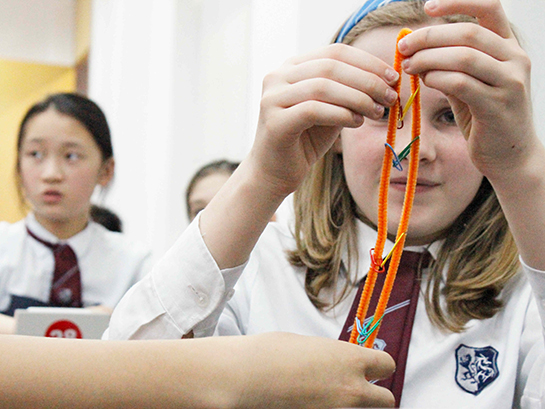

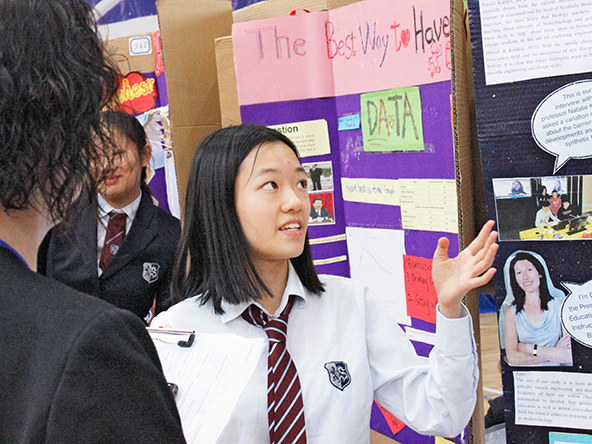
Photo Gallery
Back To Top
Home Page
Contact



